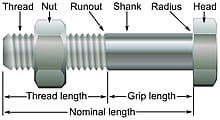struclearner
Structural
The threads of a bolt in a bolted joint with a nut can and can’t not be fall in a shear plane. This might not be an issue in a slip resistant joint where the friction between mating surfaces takes the external load.
In a tapped bolted joint with internal threads in the lower member of the joint, is this possible that threads might not fall in a shear plane, as the external threads engage with internal threads right at the shear plane, unless there is a chamfer at the hole edge.
Thanks for your comments and insight.
In a tapped bolted joint with internal threads in the lower member of the joint, is this possible that threads might not fall in a shear plane, as the external threads engage with internal threads right at the shear plane, unless there is a chamfer at the hole edge.
Thanks for your comments and insight.

